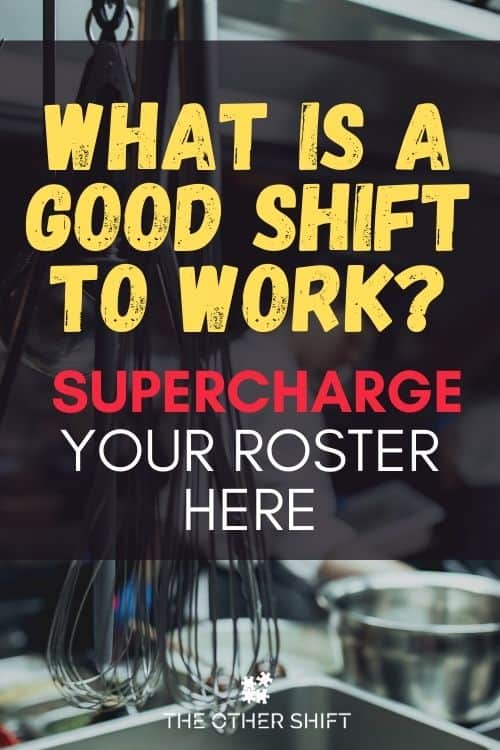Disclosure: This page may contain affiliate links, meaning we receive a commission if you decide to make a purchase through our links, but this is at no additional cost to you. Please read our disclosure and privacy statement for more info.
When it comes to shift work, not all shifts are created equal. Sometimes, when given the option to choose a shift, or when job hunting, it can be difficult to decide which shift is right for you. Picking the right shift is key in being successful at your job while maintaining a healthy work/life balance. So, what is the best shift to work?
For most, the morning shift (approximately 7am-3pm) is best as it allows for a productive workday whilst not sabotaging time away from your loved ones. It is least likely to negatively impact your health as gaining adequate sleep and vitamin D is achievable for most.

Understanding the different shifts and the terminology used for each can be difficult. In this article we are going to break down each shift type and look at the finer details. By the end of this article, you’ll be able to choose the best shift for you and your family.
Common Shift Types
When it comes to shift work, these are the three most popular types: morning, afternoon, and night shift. These are also commonly referred to as first, second and third shift, respectively.
While the start and end times can vary depending on the employer, a job using these types of shifts essentially cuts the day into three 8-hour shifts. This shift structure is most common in manufacturing facilities and warehouses, though other fields have adopted these shifts as well.
Morning
Within the three-shift structure, morning or first shift, is the most sought-after shift. It is perfect for those who consider themselves to be morning people and like spending their evenings with their families. Typically, the morning shift will start between 7am and 8am, but this is controlled by the employer.
The morning shift is often when traffic is at its heaviest, so that should be a determining factor when choosing the morning shift. Also, it tends to be the best shift for those with children involved in after-school activities such as sports.
Related post: Shift Work and Family. A Practical Guide For Busy Parents
Afternoon
The afternoon shift, or second shift, is good for those who call themselves night owls, preferring to be active at night time rather than in the morning. Generally, the afternoon shift will start between 3pm and 4pm, so it gives plenty of time to run necessary errands while still allowing for time to relax and prepare for the shift.
What attracts many to this shift is the amount of leadership staff, or I should say lack of, on duty at this time. Many feel they are able to get more work done as there are fewer bosses to get in the way, as well as fewer meetings. While each employer is different, this shift tends to be popular for those who require little supervision.
This shift is commonly referred to as the “2nd shift”. This post might come in handy about now if you work 2nd shift and have little ones running (or crawling!) around Working 2nd Shift With a Family: How to Remain a Solid Unit
Night
The night shift, or third shift, is perhaps the roughest of the three. It requires a little bit of grit and determination to get through. Though this doesn’t speak for all night shift workers. Those who absolutely love the third shift are generally those who have little to no family at home, those who identify as introverts and also those who relish the night shift environment which is commonly free from drama and a lot of people.
The third shift can include social isolation from friends and family, as you are working when almost all others are sleeping. Also, you’re preparing to go on shift while your friends are going “out on the town,” so to speak.
[VIDEO] – If you work nights and need a hand, this video will help you achieve better sleep during the day (which is certainly an area I’ve had to work on!)
Other Shift Types
There are other, not-so-common shift types on the market you may encounter when job hunting. Before we look at which shift is best, let’s take a detailed look at these shift types: split shifts, 12-hour shifts, and 24-hour shifts.
Split Shifts
Split shifts are just what their name suggests; it is a shift that breaks up the workday into two separate, often 4-hour intervals. This type of shift is generally found in the retail spectrum when split shifts allow for staffing during the busiest hours of the day. However, some employers have allowed employees to split their workday to coincide with a reoccurring appointment, such as caring for a family member on a daily basis.
Leaving occasionally in the middle of your shift for an emergency and coming back later in the day does not constitute a split shift. Also, hour-long lunch breaks do not constitute a split shift, even though you may leave the work premises.
For a shift to be called a split shift, it must be so on the books and have at least two distinct work intervals with a period of time in between where the employee is REQUIRED to leave the premises. (This is why a lunch break doesn’t count, as you are not required to leave work for a lunch break).
If you want to read more about split shifts, we wrote an entire post about it. Check it out here – Split Shifts – How Employers & Employees Can Both Benefit
12-Hour Shifts
This shift type is extremely common in the medical field and law enforcement, though more employers seem to be making the move to 12-hour shifts.
There are pros and cons to being on 12-hour shifts and many have a love/hate relationship with it. These shifts commonly run from 7am to 7pm. Also, because making 40 hours out of 12-hour shifts is nearly impossible, full-time with 12-hour shifts is generally 36 hours, meaning there are often three days working with four days off.
The number of off days is what attracts many to this shift type, though getting through a 12-hour shift is extremely hard on most days. That’s why it’s important to be health-conscious when working 12-hour shifts, as it is extremely easy to adopt an unhealthy lifestyle under the guise of “getting through” the shift.
Again, we know this shift is really common amongst our friends in the shift working world and is why we wrote a handful of posts about them. Here’s a couple for you to browse;
- How to Prepare for Your First 12 Hour Night Shift
- 10 Helpful Tips to Survive 3 Brutal 12 Hour Shifts in a Row
- 12-Hour Shift Benefits: Are Longer Shifts Really Worth it?
- You Should Meal Plan When Working 12-Hour Shifts: Here’s Why
24-Hour Shifts
24-hour shifts are the toughest, and least common, of all shift types. Fire departments are the main ones who implement a 24-hour shift. Surprisingly, many doctors are on a 24-hour shift as well. The staple, though, of a 24-hour shift is allotted sleep time.
Federal law requires employers who use this shift type to furnish sleeping quarters, as well as a designated break period for sleeping, which must be a minimum of 5 hours.
Generally, one 24-hour shift will be followed by 2-3 days off with a rare occurrence of working two 24-hour shifts with only a day between; this usually happens between shifting of staff.
What many love about this type of shift work is the vast amount of free time for families and hobbies. In fact, many who work a 24-hour shift will have a side job they work on during their off times to not feel so idle.

How Does Your Age Determine the Type of Shift Suited For You?
Though we never like to admit it, things change as we age. There comes a point where we are no longer able to move and operate as we once did, so age plays a major factor in which shift type is best for you.
As you age, your body moves slower and requires more downtime, so extended shift hours are not great. Also, there have been many studies done that show working shifts such as night shift and 24-hour shifts can age your body quicker than other shift types. Now, that’s not saying that those further along in age aren’t capable of working these rougher shifts, but when it comes to an ideal shift for your age, choose wisely.
Keep in mind, when you enter a new job at the bottom of the seniority list, your chances of working a prime time slot, such as the morning shift, can be difficult. This is why shifts, such as the night shift, are often worked by the younger workforce. But, as you put in years at the same job and your seniority grows, the more likely you are to win a bid for a shift starting earlier in the day. This is a major point where age makes a difference, especially when that age equates to a longer time on the job.
For those a little older and who are considering a career in nursing, you’ll appreciate this post – Am I Too Old to Become a Nurse? 7 Tips for Joining After 40.

What Would Be The Easiest Shift To Work?
When we seek a general consensus from our shift working friends, an overwhelming majority agree working the morning shift is easiest. There’s often more social interaction while on the job, along with added time spent with family and friends in the evening.
While most other shift types come with what is known as a shift differential, meaning a higher pay rate for a not-so-popular shift, they often cause added strain on relationships and stress between your work and life, not to mention disrupting your natural sleep patterns.
Morning shift, on the other hand, falls in sync with your natural life rhythm; waking up in the morning, go to work, come home and relax. When working other shift types, the lack of sleep, or the disruption of the normal sleeping pattern, is often what makes them difficult and requires extra preparation.
From a viewpoint of work intensity, those who love the night shift often enjoy it more as they say it is easier to get your work done. Plus, the off shifts tend to be more laid back, allowing for more fun interaction between workers, which tends to make these shifts go by much faster.
We also notice a really strong bond established between those who work the afternoon / night shift, as they can relate to the same challenges and all people miss out on the same family / social time outside the workplace.
If night shift does sound appealing read this first. Work from Home Night Shift Jobs: A Must Read Before Applying

What Would be Deemed the Healthiest Shift to Work?
The morning shift is considered by many to be the healthiest shift to work, though this can also include a 12-hour shift that starts in the morning.
Other shift types, especially night shift, tend to promote an unhealthy way of living, from disrupted sleeping to unhealthy eating habits under the guise of “getting the work done.” This often includes copious amounts of energy drinks and other forms of caffeine.
If you’re interested to learn more about caffeine and how shift workers can use it wisely, this post will help.
Morning shift also seems to allow the most opportunity to hit the gym, though many who work 24-hour shifts will spend their off days in the gym and working out. Many who work other shifts besides the morning report wanting to sleep more as they never feel they are fully rested. This often leads to a lower desire to do anything other than going to work and come home to sleep.
That being said, it is possible to live a healthy lifestyle while working any of these shifts. The complexity though, is that it requires an added focus and a person’s health is often put on the back-burner.
We care about your health here though! These posts may help you prioritize your health as a 3rd shift worker;
- How Can I Boost My Immune System When Working Night Shift?
- How To Work The Night Shift and Stay Healthy
- I Work Night Shift, But Don’t Want Low Testosterone. Help
- [VIDEO] – How to stay healthy as a rotating shift worker
Choosing the Right Shift for You?
When choosing which shift works best for you, there are several factors you need to take into consideration, the first of which should be your family life. If you don’t have a spouse and/or children, spending time at home with your family might not be as important as someone who does. On the flip side, looking at how active your social life is should be just as big of a factor on which shift you choose too.
We recently released a video titled; Night Shift Relationships: How To Not Ruin Them which gives plenty of tips to keep your relationships alive.
Career choice also plays heavily into which shift-type you work. Those in the nursing field will likely find 12-hour shifts dominate, though 8-hour shifts were once the norm.
Also, as mentioned earlier, if you are going into a rescue / life-saving field such as firemen, a 24-hour shift will be the norm. If there’s a shift you absolutely don’t want to work, be sure the career field you choose doesn’t have that shift-type as a standard option.
What type of personality you have plays heavily into your shift decision as well.
Introverts tend to prefer the night shift as it equals fewer people around and less social interaction. Extroverts, on the other hand, prefer the day shift as it promotes more interaction.
If your personality is one to take charge and be in leadership, you will likely shoot for a shift that works during the day also, as this is when most senior leadership roles are required.
Pay, though, is often a leading reason why many choose the not-so-popular shifts. As mentioned earlier, most employers will pay a shift differential for working the second and third shifts, with each having a higher pay rate than the other.
In many cases, second shift differential is around .50-cents more an hour while third shift is around $1 more an hour (source). This differential is also higher for those in leadership roles. Salary loading is often also added to the 12-hour shifts which work in the evening times, in addition to 24-hour shifts.
Related post: 9 Myths About Night Shift Jobs You Probably Still Believe

Keep Reading;
- Pros and Cons of Night Shift vs Day Shift. Who Wins?
- What Do the Terms 1st, 2nd and 3rd Shift Actually Mean?
- [VIDEO] – Working Night Shift? Usable Guide to Your Days Off
Summary: What is a Good Shift to Work?
Overall, you are the final deciding factor on what is a good shift to work. As life changes, so does the needs you have in a shift.
Try and find an employer who allows for the changing of shifts periodically through shifts bids. This will give you a chance at changing your work schedule as your life changes.
If not, then a solid work/life balance is critical to ones overall health and wellbeing and if a certain shift type doesn’t work for you any longer, don’t be afraid to have the conversation with your boss or manager. A change could be beneficial to you and the overall business.
Cheers,

Disclosure: This page may contain affiliate links, meaning we receive a commission if you decide to make a purchase through our links, but this is at no additional cost to you. Please read our disclosure and privacy statement for more info.
Disclosure: This page may contain affiliate links, meaning we receive a commission if you decide to make a purchase through our links, but this is at no additional cost to you. Please read our disclosure and privacy statement for more info.
Recent Posts
Is Becoming a Veterinarian More Difficult Than Becoming a Doctor?
Choosing between whether to become a veterinarian or a doctor can be vexing. While they are similar in scope of knowledge, they are vastly different in terms of time consumed and money...
Is a Trucker's Life Hard? Quick Facts About Life on the Road
For many people, work will revolve around a commute to a destination. Whether that place is a school, factory, or bar, one thing is universal: we all hate traffic. What if there were a job where...

